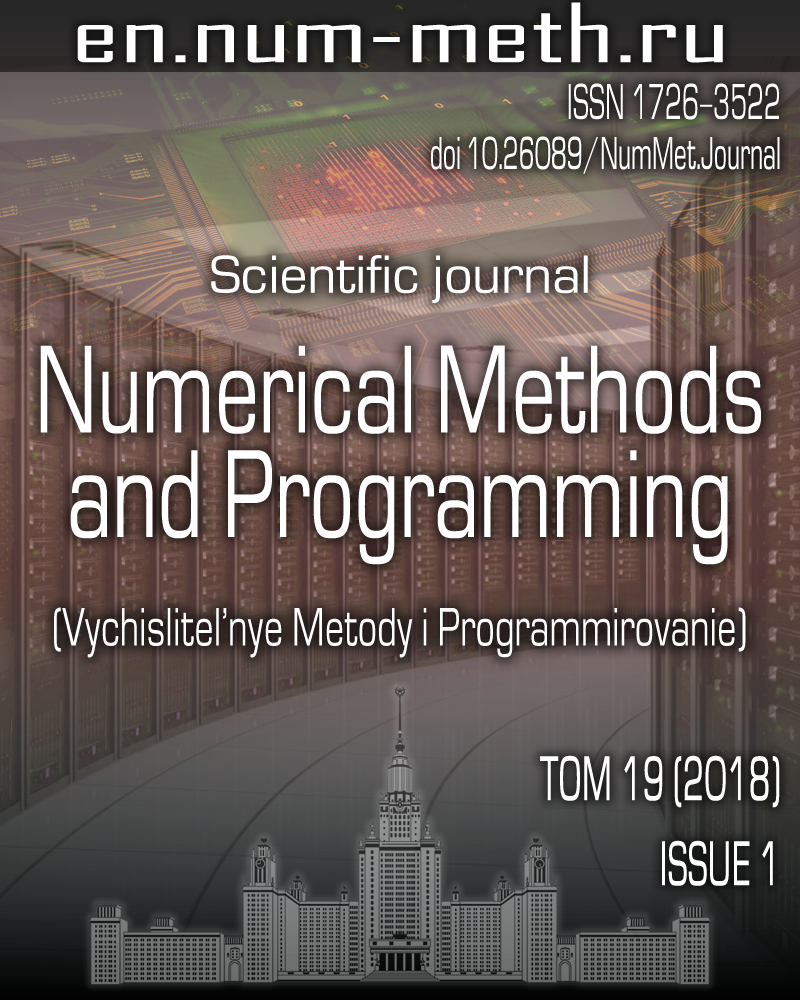DOI: https://doi.org/10.26089/NumMet.v19r105
A method of adaptive artificial viscosity for solving numerically the equations of a viscous heat-conducting compressible gas
Keywords:
numerical simulation
gas dynamics
unstructured meshes
artificial viscosity
Abstract
This paper is devoted to the numerical solution of the dynamics equations for a viscous heat-conducting compressible gas by the method of adaptive viscosity on unstructured tetrahedral meshes. A combination of the MacCormack method and the Lax-Wendroff method allows one to monotonize the difference scheme using the method of frozen coefficients. The numerical results are in good agreement with experimental data.
Published
2018-02-11
Issue
Section
Section 1. Numerical methods and applications
References
- I. V. Popov and I. V. Fryazinov, “Finite-Difference Method for Solving Gas Dynamics Equations Using Adaptive Artificial Viscosity,” Mat. Model. 20 (8), 48-60 (2008) [Math. Models Comput. Simul. 1 (4), 493-502 (2009)].
- I. V. Popov and I. V. Fryazinov, “Adaptive Artificial Viscosity for Multidimensional Gas Dynamics for Euler Variables in Cartesian Coordinates,” Mat. Model. 22 (1), 32-45 (2010) [Math. Models Comput. Simul. 2 (4), 429-442 (2010)].
- I. V. Popov and I. V. Fryazinov, “Calculations of Two-Dimensional Test Problems by the Method of Adaptive Viscosity,” Mat. Model. 22 (5), 57-66 (2010) [Math. Models Comput. Simul. 2 (6), 724-732 (2010)].
- I. V. Popov and I. V. Fryazinov, “A Method of Adaptive Artificial Viscosity,” Mat. Model. 22 (7), 121-128 (2010) [Math. Models Comput. Simul. 3 (1), 18-24 (2011)].
- I. V. Popov and I. V. Fryazinov, “On the New Choice of Adaptive Artificial Viscosity,” Mat. Model. 22 (12), 23-32 (2010) [Math. Models Comput. Simul. 3 (4), 411-418 (2011)].
- I. V. Popov and I. V. Fryazinov, “Finite-Difference Method for Computation of 3-D Gas Dynamics Equations with Artificial Viscosity,” Mat. Model. 23 (3), 89-100 (2011) [Math. Models Comput. Simul. 3 (5), 587-595 (2011)].
- I. V. Popov and I. V. Fryazinov, “Method of Adaptive Artificial Viscosity for Gas Dynamics Equations on Triangular and Tetrahedral Grids,” Mat. Model. 24 (6), 109-127 (2012) [Math. Models Comput. Simul. 5 (1), 50-62 (2013)].
- A. A. Samarskii, A. V. Koldoba, Yu. A. Poveshchenko, et al., Difference Schemes on Irregular Grids (Kriterii, Minsk, 1996) [in Russian].
- A. A. Samarskii and Yu. P. Popov, Difference Schemes for Solving Gas Dynamics Problems (Nauka, Moscow, 1992) [in Russian].
- T. G. Elizarova, Quasi-Gas-Dynamic Equations and Methods of Calculation of Viscous Flows (Nauchnyi Mir, Moscow, 2007) [in Russian].
- P. Lax and B. Wendroff, “Systems of Conservation Laws,” Commun. Pure Appl. Math. 13 (2), 217-237 (1960).
- R. W. MacCormack, “The Effect of Viscosity in Hypervelocity Impact Cratering,” AIAA Paper No. 69-354 (1969).
- C. Geuzaine and J.-F. Remacle, “Gmsh: A Three-Dimensional Finite Element Mesh Generator with Built-in Pre- and Post-Processing Facilities,” Int. J. Numer. Meth. Eng. 79 (11), 1309-1331 (2009).


